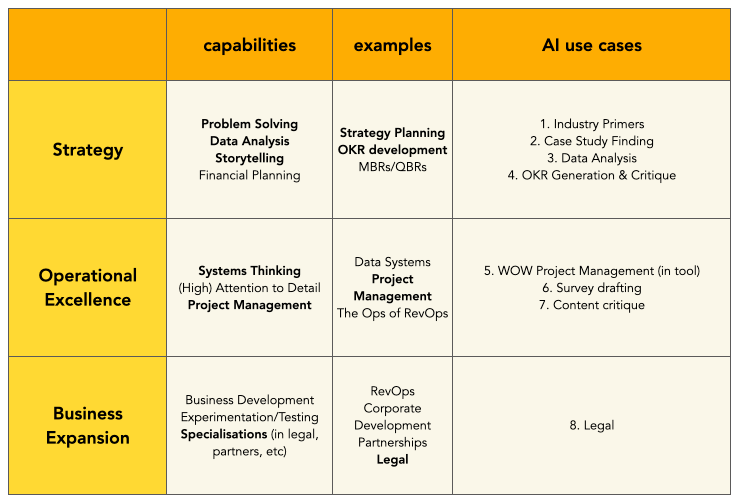How Strategy & Ops professionals use AI
From COOs to BizOps ICs, early adopters share their experiments 👩🏻🔬
From COOs, to one (wo)men band BizOps teams, it seems that everyone has been experimenting with AI to make organisations more efficient, more scalable, or just plain faster. I recently spoke to 20 Strategy & Ops pros, in companies in the UK and the US, ranging from 50 people to 800, with varied revenues, and both SaaS and marketplaces, to delve into how are they using AI in their day-to-day.
Side note: I expect that this post will be the one that ages fastest, so for the record, this is relevant in October 2024. In November, we will have to see.. 🤗
Right off the bat, here are my top 3 learnings:
COOs are experimenting with three types of AI use, comparing:
Software Companies’ AI (think Notion AI, Salesforce etc),
Emerging platforms (OpenAI/Anthropic), or
new kids on the block (specialised AI start ups like Sana, Cradl, or Logicstar)
The question of “build or buy” is mainly answered with “buy, duh”, and “build” is only considered where AI can power a company’s product in a way that supercharges its value to the customer.
Companies that are doing well, use AI to raise the bar on performance, not a reason to downsize their workforce.
Context is king.
AI, in its various forms, is a great prompt to our own thinking. No-one takes it at face value, it always needs editing, and if it produces a good enough result, it propels us to higher planes of complexity. For example, an analyst whose job once might have been to create an industry report, can now do this much faster, and use it as a robust launchpad to think more creatively about the “So what?” at the end. A win-win!
As JB of Gigantec puts it:
“Junior-to-Mid level people are 30-40% more efficient, so the bar is higher. If you are growing, you are not thinking about workforce reduction, you are thinking about capturing that extra growth.”
Here are 8 use cases professionals shared with me. I have split them based on the BizOps function matrix. In bold I have put the capabilities, and example domains, that were mentioned. Scroll to the end for a bonus!
1. The Industry Primer
objective: understand an industry landscape, including size, growth, trends, competitors, key ecosystem players, tech drivers, regulation etc.
preferred tool: Perplexity, ChatGPT
best practices: be specific about the format of the output. Use multiple tools to get a comprehensive answer.
steps:
Pre-prime the AI with your personal context (e.g. who are you, where are you working, what is the project you are working on, why do you need a primer)
Specify the desired output
Provide as much context as possible about the scope of the industry primer (e.g. publishing vs newspapers)
Request specific information (e.g. GDPR, UK GDPR, CCPA etc)
challenges: AI may not always provide comprehensive insights. Doesn’t have access to proprietary reports, so the information may not be 100% up to date. Requires manual verification and refinement.
2. Case Studies
objective: find case studies to learn best practices for tackling analogous business challenges
preferred tool: ChatGPT
best practices: be specific about the concept you are looking for. I find it useful to boil down a story to its simplest parts to prompt the AI. Ask for 5-10 examples to get a few good ones.
steps:
boil down the story to a sentence or two.
prompt the AI asking for a number of examples, with a specific length.
you can ask follow up questions to delve into the case study in the areas that interest you.
challenges: verify the examples. I find doing this with Perplexity works best.
3. Data Analysis
objective: find insights quickly; or validate your own code for use with query tools
preferred tool: ChatGPT, Claude
best practices: before you put any proprietary data in the tool, make sure you have signed an Enterprise privacy policy. Use Claude for code coaching work due to its accuracy and simplicity.
steps:
clean the data (you can use the tool to audit or recommend complex Excel/Python/SQL formulas, serving as a personal coach)
ask for a segmentation of the data; ask for multiple variations of the names or concepts of the segments
ask it about the top 10 insights
ask in the end if it is forgetting anything
challenges: this is best done on data you are familiar with, so you can spot any potential missteps.
4. OKRs Generation & Critique
objective: craft robust OKRs
preferred tool: ChatGPT, Claude
best practices: pre-prompt the AI to obtain results that are MECE. Input how you want it to treat BAU (separate KPIs, or as part of OKRs but where OKRs are split in base and stretch scenario).
steps:
ask your Leadership team for the common themes of challenges and opportunities.
pre-prompt the AI with the context of your company, and departments health.
use AI to generate a broad list of potential OKRs.
in a session with the Leadership team, select and refine the most relevant OKRs.
in the end, use the AI to critique the OKRs (e.g. what have we missed?)
challenges: AI-generated OKRs may not be fully applicable. Requires selection and refinement. Most importantly, it doesn’t substitute the real thinking that needs to go into crafting OKRs.
5. Project Management (e.g. Contract Tracking)
objective: track the changes in commercial contracts
preferred tool: Cradl AI
best practices: Use Cradl AI to connect with G Sheets.
steps:
convert papers into DOCX files, rather than PDFs
set up Cradl AI to intake through email or a web hook
Cradl AI then outputs the key fields
hook it to G sheets to input the key fields, allowing observability of the paperwork (e.g. what service levels are required? what about those liability caps?)
set it up to trigger warnings
challenges: needs to fully integrated into the way of working (WOW) of the commercial team.
6. Survey Drafting
objective: draft customer surveys
preferred tool: Claude
best practices: pre prompt with the output, requesting questions that are a specific length, and are overall MECE
steps:
identify what you want to get out of a survey
prompt with as much context as possible about the customers you are talking to
provide a number of areas of exploration that you want the AI to touch on in its draft
ask the AI to draft survey questions, by asking for a lot of questions first, and then fewer to narrow down.
estimate survey timing, and choose the desired complexity.
for longer surveys where you want to ask the same question multiple times but in different format, you can ask for multiple versions of the same questions
challenges: while its writing can be good, AI struggles with qualitative data analysis; results often feel generic. Also it cannot quote properly.
7. Content Critique
objective: write compelling content or presentations
preferred tool: Claude
best practices: pre-prompt the AI with your ICP and Persona; or audience. Again, give as much context as possible. Ask it to use only this information and nothing else.
steps:
upload your presentation or content
ask it what % of the content resonates with this audience
ask how it would change it better
pro tip: ask if it can summarise the presentation in one sentence. Then to provide other analogous stories, such that are written in a very inspirational, or practical terms. Then ask to amend your presentation, in that style. It can be surprisingly good.
challenges: It can sound generic. Claude is better than ChatGPT in this.
8. Legal negotiations
objective: on the back of tracking changes, enable commercial teams to run the first pass at negotiations
preferred tool: ChatGPT
best practices: pre-prompt the AI with your legal paperwork. Ask it to use only this and nothing from its general library of content. Ensure Cradl AI is connected with G Sheets for traceability.
steps:
pre-train the GPT on your paper, and the boundaries of what you accept and not accept
pre-train on the output format (e.g. a table with specific clauses, standard position, requested position, and deviation)
commercial teams then can use that GPT to upload docs, quickly identify key areas of negotiations
challenges: unless trained very strictly, the GPT can hallucinate. Needs verification.
In this post I focus on the early adoption practices. This is (some of) the use cases we see right now. I can’t stress enough how fast this is evolving and how chances are all of these will evolve shortly.
The outcomes from these use cases are still patchy: in some areas you gain a lot of speed, skill, or overcome the fear of asking ‘stupid’ questions. In others, the use cases are still not fully useful. Some are very hard to measure. But overall the use of AI helps you jumpstart your thinking, augment your creative process, and get to a higher level of complexity. This is still fast-evolving so I am looking forward to seeing what else we can do! For now, we can also have some fun:
🪄 And now, as promised, a bonus use case:
objective: create a roast for your little brother
best practices: ask the tool to be sarcastic
steps:
go to instagram, and take a screen shot of his account
upload the screen shot into ChatGPT or Claude
ask it to create a 100 word roast that you are planning on using during a speech for his birthday
outcome: enjoy!



